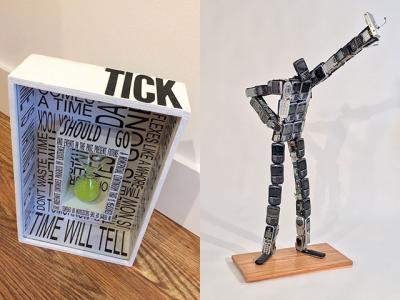What’s Become of the Time?

The representation of time has been an enduring concern of art through the ages. Beyond the classical “vanitas” or still life genres, an exhibition at the Sara Nightingdale Gallery in Sag Harbor provides a modest sampling of how artists address similar themes today.
The exhibition, “No Longer Supported,” addresses time’s passage on several levels, including technological change and obsolescence, the passage of seasons, deadlines and schedules, calendars and alarm clocks, and the accumulation of years until an ultimate demise. Time stops, moves forward, and folds in on itself. “Is time progressing or regressing?” asks Ms. Nightingale, an allusion, perhaps, to Nietzsche’s eternal return.
With regional artists as well as those from further away, she has brought together Peter Buchman, Perry Burns, Stephanie Brody-Lederman, Darlene Charneco, Bill Claps, Rossa Cole, James Croak, Cara Enteles, Barbara Friedman, Peter Garfield, Shirley Irons, Steven Kinder, Elena Lyakir, Ruth Ava Lyons, Christa Maiwald, Karyn Mannix, Dalton Portella, Anne Raymond, Bonnie Rychlak, Maggie Simonelli, George Singer, Ross Watts, and Libby Wadsworth in the exhibition
Given how abstract the concept of time is, it would seem to be impossible for it to be communicated visually aside from a clock face, a calendar, or a digital watch. The artists assembled here have done it directly and indirectly in ways that encourage reflection.
While there are plenty of two-dimensional works, Ms. Nightingale also has amassed some quite different takes and materials. James Croak’s “Shovel” is a sculpture of a hand, propped against a wall in a way that makes it look as if it is emerging from it. In the hand’s grasp is the handle for a shovel, which reaches the floor and provides the base and support for the piece. The shovel is a blunt instrument, with an old school form that people still use. But there is also something morbid implied, a hint of “ask not for whom the shovel digs, it digs for thee.”
In the same room, Rossa Cole continues his repurposing of found objects, branching out from what he finds on beaches to old cellphone handsets. Adopting the attenuated legs and sweeping gestures of Bill King, Mr. Cole’s “Nam June Paik Takes a Selfie” has one hand on his hip and another arm the length of a selfie stick. It is charming and whimsical, and the amount and type of cellphones used, all recognizable from recent memory, packs a deeper punch in terms of just how much waste there is in this era of rapidly changing tech.
Christa Maiwald’s “Coffee Cake (For Jackson Pollock)” features her handmade embroidery, a commercially made placemat and mug, and a slice of real cake that has been sitting in the gallery since the show opened. The embroidery depicts a mug of coffee spilling its contents on the cake and mat below. The artist stops time with the depiction, but makes the piece vulnerable to time’s passage as well. Her reference to a mythologized artist of the past, whose wide appeal has been translated into mass produced tchotchkes, says something else about time’s passage. Could Pollock have ever imagined that more than 100 years after his birth someone would add coffee dribbles from a drip-painted mug to a drip painting placemat?
In Peter Buchman’s pieces, such as “Once Upon a Time,” time is addressed through words that also have physical properties. With raised industrial style lettering, he collects a multitude of expressions: “Time is money,” “ticking time bomb,” “just in the nick of time,” and so on. “New York Time,” written in The New York Times’s characteristic font, also plays with meanings and associations like the pace of a news cycle and the expression “faster than a New York minute.” Superficially pithy, he packs a lot to contemplate into these pieces.
Also working with words and numerals, Ross Watts has painted in straight palindromic numbers, “1 2 0 2 0 2 1,” and the more explicit, “JAN.20.2021.” Both refer to the date of the next presidential inauguration and feature his built up and sanded surfaces, which give his work the gravitas of found tablets.
The “Morphed Florida Drains” of Bonnie Rychlak are made of hand-carved wax. After leaving the works outside in Florida for several years, the hot sun has caused them to warp and altered their once perfect symmetry, adding its own message about time. The wax varies in color slightly from piece to piece, but resembles the matte tones of sea glass.
Maggie Simonelli has incorporated change in her encaustic panels by using copper leaf as part of the composition. Over time, the copper’s natural pigment develops its greenish patina. The gold leaf she includes serves as a complement and then a contrast to the changing hues. Her subject, “Wind & Grasses,” is well suited to the materials both before and after the transformation.
There is plenty more to see and savor here, but “time’s a wasting.” The show closes Monday.
